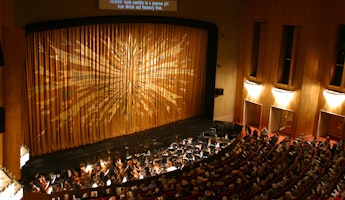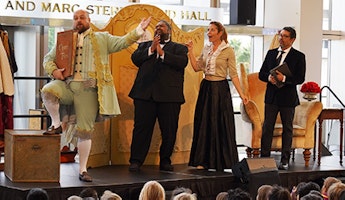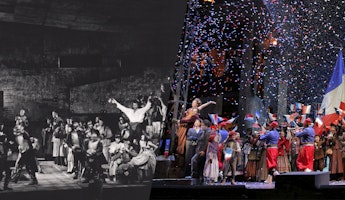Blog
May 8, 2024
The Aria That Took The World By Storm
It’s not very often that an aria becomes vastly more popular than the opera it originates from, but that’s most certainly the case for “Nessun dorma.” Originating in Puccini’s Turandot, the aria (which translates to English as “Let no one sleep”) became a worldwide phenomenon thanks to Luciano Pavarotti. Even if you’re not familiar with the title, we’re sure you’ve heard it many times, at sporting events or in covers by various pop artists or one of the dozens of movies and TV shows it’s been featured in. Let’s see why the aria stands out in Turandot and what made it take off in popularity.
Briefly, for those who are unfamiliar with Turandot’s story, the opera follows a prince who risks his life when he accepts Princess Turandot’s challenge to answer three riddles. If he answers correctly, she will marry him; if he fails, he will be beheaded. By the end of the second act, the prince has successfully answered the riddles, but the princess shrinks from her promise to marry him. The prince offers her a riddle of his own: if she can find out his name before dawn, she can have him put to death, but if not, she must marry him. This leads us to the third act of the opera, which opens with a proclamation that nobody in the kingdom will sleep until the prince’s name is discovered. The aria “Nessun dorma” follows, in which the prince dreams of revealing his name as dawn arrives, believing that he will win her heart. It’s the opera’s grandest statement of love, set to Puccini’s soaring music and heightened by the tension of the story. It’s further engrained into the audience’s memory at the opera’s close, with an even grander reprise of the tune after Turandot declares her love for the prince.
Turandot became a sensation in the opera world for its musical and theatrical splendor as well as its historical legacy as Puccini’s last opera. “Nessun dorma” quickly became a staple aria in the opera world with many singers singing it for recitals or concerts. The legendary Luciano Pavarotti helped the aria break into the stratosphere when he performed the piece for a global audience at the 1990 FIFA World Cup. This World Cup had an estimate of 26.69 billion viewers, shining a spotlight on the aria that few pieces of classical music had ever had before. Pavarotti subsequently released a single of the aria that reached number two in the UK. Another famed tenor, Jose Carreras sang the aria at subsequent World Cups in 1994, 1998 and 2002, solidifying its impact. To date, this single YouTube recording (there are others) of Pavarotti performing it has over 70 million views.
With the aria’s popularity skyrocketing, musicians as varied as Roy Orbison, Jeff Beck, Aretha Franklin, Jennfier Hudson, Michael Bolton, Adam Lambert and countless others would perform covers of the tune or implement the melody in songs of their own. Hollywood couldn’t ignore its popularity, and the aria has been featured in a multitude of television shows and movies. Some notable works include Mission: Impossible – Rogue Nation, The Upside, New York Stories, The Killing Fields and Daredevil. And it wasn’t just American media. The aria was also featured in the Korean drama Vincenzo and the 1993 anime adaptation of Jojo’s Bizarre Adventure.
All of this goes to show just how extraordinarily popular this aria has become, reaching an audience far beyond anything else in opera in the modern age. And with Puccini passing away before the completion of Turandot, is there a better way of remembering his legacy than by continuing to perform this work, one of the very last pieces of music he wrote? We’re sure “Nessun dorma” will continue to be loved by future generations of opera fans and non-opera fans alike. And we’re also sure that Puccini would be smiling if he were here to see it today.
To hear Russel Thomas' thoughts, our current Calaf, on singing this iconic aria click here.








/03-cosi/_dsc0996_pr.jpg?format=auto&fit=crop&w=345&h=200&auto=format)















